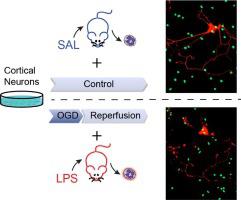Journal of Neuroscience Methods ( IF 2.7 ) Pub Date : 2020-05-20 , DOI: 10.1016/j.jneumeth.2020.108782 Nguyen Mai 1 , Viollandi Prifti 1 , Minsoo Kim 2 , Marc W Halterman 3

|
Background
Immune-mediated reperfusion injury is a critical component of post-ischemic central nervous system (CNS) damage. In this context, the activation and recruitment of polymorphonuclear neutrophils (PMNs) to the CNS induces neurotoxicity in part through the release of degradative enzymes, cytokines, and reactive oxygen species. However, the extent to which close-range interactions between PMNs and neurons contribute to injury in this context has not been directly investigated.
New method
We devised a co-culture model to investigate mechanisms of PMN-dependent neurotoxicity. Specifically, we established the effect of PMN dose, co-incident neuronal ischemia, lipopolysaccharide (LPS)-induced PMN priming, and the requirement for cell-cell contact on cumulative neuron damage.
Results and comparison to existing method(s)
Pre-exposure of day in vitro 10 primary cortical neurons to oxygen-glucose deprivation (OGD) enhanced PMN-dependent neuronal death. Likewise, LPS-induced priming of the PMN donor further increased PMN-induced toxicity in vitro compared to saline-injected controls. Compartmentalization of LPS-primed PMNs using net wells confirmed the requirement for close-range cell-cell interactions in the process of PMN-induced neuronal injury. Moreover, time-lapse imaging and quantitative neurite analyses implicate PMN-neurite interactions in this pathological response. These experiments establish a platform to investigate immune and neural factors that contribute to post-ischemic neurodegeneration.
Conclusions
Ischemic and immune priming enhance neurotoxicity in PMN-neuronal co-cultures. Moreover, cell-cell contact and neurite destruction are prominent features in the observed mechanism of post-ischemic neuronal death.
中文翻译:

中性粒细胞-神经元共培养物的特征,以研究缺血后免疫介导的神经毒性的机制。
背景
免疫介导的再灌注损伤是缺血后中枢神经系统(CNS)损伤的重要组成部分。在这种情况下,多形核中性粒细胞(PMN)的激活和募集到CNS会部分通过释放降解酶,细胞因子和活性氧来诱导神经毒性。但是,在这种情况下,PMN和神经元之间的近距离相互作用在多大程度上导致了损伤,目前尚无直接研究。
新方法
我们设计了一种共培养模型来研究PMN依赖性神经毒性的机制。具体而言,我们确定了PMN剂量,同时发生的神经元缺血,脂多糖(LPS)诱导的PMN引发以及细胞与细胞接触对累积神经元损伤的要求的影响。
结果和与现有方法的比较
每天在体外对10个主要皮层神经元进行氧-葡萄糖剥夺(OGD)的预暴露增强了PMN依赖性神经元死亡。同样,与注射盐水的对照组相比,LPS诱导的PMN供体的引发进一步增加了PMN诱导的体外毒性。使用网孔对LPS引发的PMN进行区室化,证实了在PMN诱导的神经元损伤过程中需要进行近距离的细胞间相互作用。此外,延时成像和定量神经突分析暗示了PMN神经突相互作用在这种病理反应中。这些实验建立了一个平台,以研究有助于缺血后神经变性的免疫和神经因素。
结论
缺血和免疫引发可增强PMN-神经元共培养物中的神经毒性。此外,在观察到的缺血后神经元死亡机制中,细胞间接触和神经突破坏是显着特征。











































 京公网安备 11010802027423号
京公网安备 11010802027423号